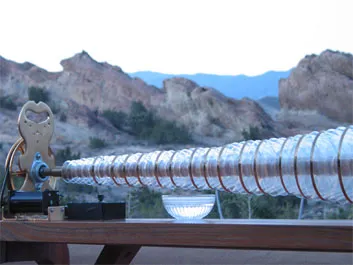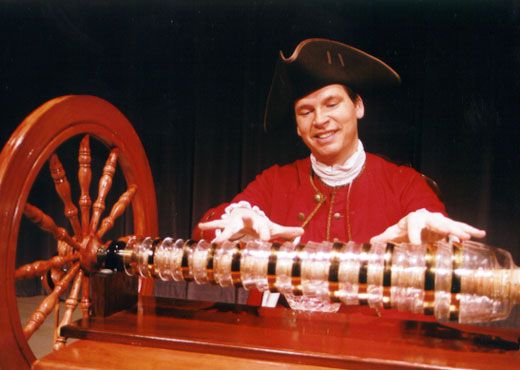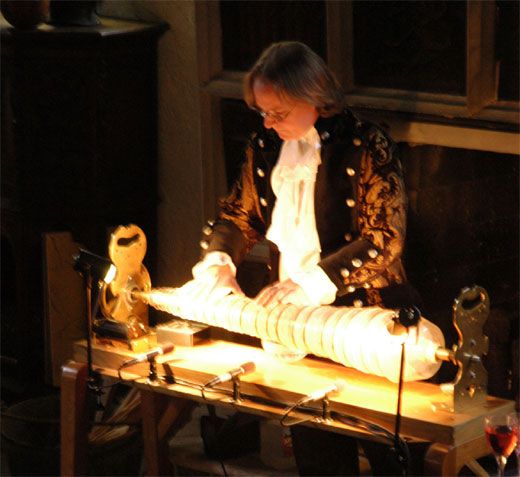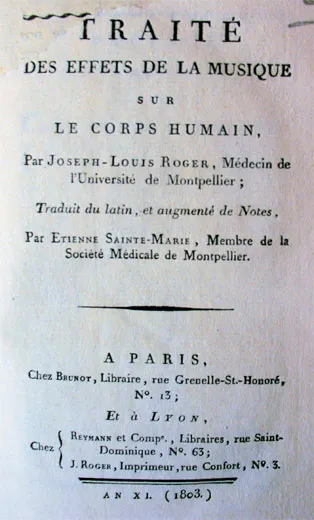Second Time Around
Invented by Ben Franklin but lost to history, the glass harmonica has been resurrected by modern musicians
If you have ever entertained dinner guests by running a wet fingertip around the edge of a crystal goblet to create a musical tone, you have experienced the pure sound that inspired one of Benjamin Franklin's most fantastical creations, the glass armonica. Despite Franklin's lasting contributions to science and politics, his favorite invention was perhaps this rare creation: "Of all my inventions, the glass armonica has given me the greatest personal satisfaction," he wrote. This beloved instrument disappeared mysteriously from the musical landscape in the 19th century, but is now enjoying a renaissance.
While living abroad as a delegate for colonial America, Franklin enjoyed concerts in which musicians coaxed notes from wine glasses, varying those notes with different amounts of water in each glass. Franklin, being Franklin, decided he could do better: "I wished only to see the glasses disposed in a more convenient form, and brought together in a narrower compass, so as to admit of a greater number of tunes and all within reach of hand to a person sitting before the instrument," he wrote. He completed his first glass armonica in 1761.
To eliminate the need for water, he commissioned a London glassblower to make a series of bowls in different sizes, each tuned to a specific note by virtue of its radius and thickness. Each bowl had a hole in the center; Franklin nested them in a row on an iron rod and placed the rod horizontally in a cabinet. Franklin then attached the rod to a wheel, which he turned with a foot treadle much like early sewing machines. The row of bowls resembled a piano keyboard; he painted the rims different colors to identify the notes. By touching the spinning bowls with wet fingers he produced chords and complex melodies.
Franklin brought his armonica with him wherever he traveled, and took particular pleasure in entertaining his friends with Scottish tunes. As word of his invention spread, glassblowers produced several thousand armonicas in the next few years. The haunting music filled parlors and concert halls across Europe and America. Eventually Mozart and Beethoven composed music for it. Dr. Franz Anton Mesmer, who employed hypnosis to treat a variety of ills, used the ethereal sound to induce deeper trances in his patients.
Over time, however, reports circulated about glass armonica players suffering a variety of symptoms, from loss of feeling in their hands to nervous disorders. Rumors spread that the music itself could cause mental illness. The author of a 1788 manual on the armonica advised that some people avoid playing the instrument, "in order that their state of mind not be aggravated."
Some speculated that lead in the glass and paint induced lead poisoning; that theory has never been proven. Perhaps the challenge of transporting a glass instrument proved too daunting. Or maybe the relatively quiet armonica couldn't compete with more robust instruments. Whatever the reason, by the early 19th century, the armonica had fallen out of favor.
That all changed in the 1980s, when inventor and glassblower Gerhard Finkenbeiner of Waltham, Massachusetts, began producing the instrument. Finkenbeiner, an expert in blowing custom glass for scientific uses, had seen an armonica in a German museum as a child and had never forgotten it. Much like Franklin, Finkenbeiner loved the sound and wanted to share it with the world. He began producing armonicas made of quartz, which is 99.9 percent pure silica and yields remarkably clear sound waves. "Once you've heard the clarity of the quartz, there's no going back," says Thomas Hession, who has blown the glass for Finkenbeiner's armonicas since the master's death a few years ago. Finkenbeiner also modernized the instrument by using an electric motor to turn the bowls.
G. Finkenbeiner, Inc., where the main business is the manufacture of highly-specialized glass for scientific uses, has produced more than 200 of these musical instruments, ranging in price from $7,000 to $40,000. Customers have included the Sultan of Oman, the producers of the television hit "Extreme Makeover Home Edition" and a handful of professional musicians.
Those professionals have played the armonica at venues ranging from music festivals to Disney World. Through their passion, the hauntingly beautiful sound is spreading and can now be heard in movie soundtracks and the Metropolitan Opera Orchestra. The year-long celebration of Franklin's 300th birthday in 2006 also gave the instrument a boost in visibility.
Those enamored of the instrument, like Cecelia Brauer of New York, want everyone to know about it. A professional pianist who performs educational programs at museums, historical sites and schools, Brauer discovered the armonica in 1990. The Daughters of the American Revolution will recognize musician William Zeitler with their Medal of Honor this month for his efforts in bringing back the armonica. "This instrument has been around a long time, and I'm glad to help bring it into the 21st century," says Zeitler, who is also writing a book on the instrument.
Dean Shostak, who performs more than 200 armonica concerts a year in the United States and abroad, is the only one to play with a foot pedal as Franklin did. Steeped in the instrument's history, he recalls reading tantalizing accounts of the armonica. "The stories talked about how the music affected audiences, how it captured the audience in a way you have to hear to really understand," he says.
Like his fellow aficionados, Shostak revels in the instrument's past and looks with excitement to the future: "Franklin had a spirit of musical adventure that I feel was lost for a time," he says. "Maybe the glass armonica will show us the way back to that spirit."




